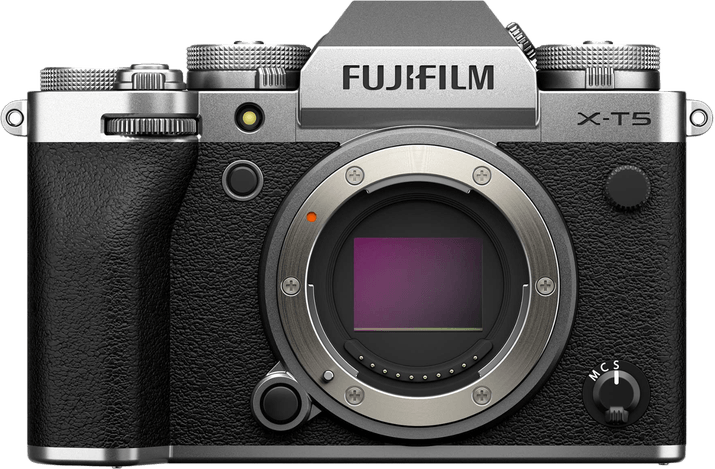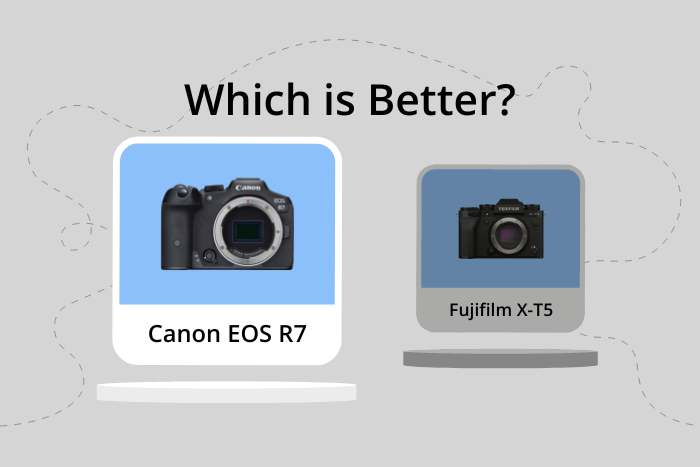Canon EOS R7 vs Fujifilm X-T5 Comparison
Canon EOS R7

Fujifilm X-T5

The Canon EOS R7 emerges as the winner with a score of 83/100, slightly ahead of the Fujifilm X-T5‘s 81/100. Both cameras are mirrorless and were released in 2022. They share similarities in size, with the Canon EOS R7 measuring 132 x 90 x 92mm and the Fujifilm X-T5 at 130 x 91 x 64mm.
The Canon EOS R7 outshines the Fujifilm X-T5 with a lower launch price of $1500 compared to the Fujifilm X-T5’s $1699. However, the Fujifilm X-T5 has a lighter weight of 557g, making it more portable than the Canon EOS R7, which weighs 612g.
Taking into account the scores, price, and weight, the Canon EOS R7 offers better value for money, while the Fujifilm X-T5 provides a more lightweight option for those prioritizing portability.
Canon EOS R7 vs Fujifilm X-T5 Overview and Optics
The Canon EOS R7 comes out on top in our optics comparison with a score of 82/100, while the Fujifilm X-T5 follows closely behind with a score of 81/100. Both cameras share several common specifications, including a CMOS sensor, APS-C sensor size, 15 fps shooting speed, and image stabilization. Additionally, both cameras utilize their respective brand’s lens mounts – Canon RF for the EOS R7 and Fujifilm X for the X-T5.
The Canon EOS R7 edges ahead due to its Digic X processor and a DXOMARK sensor score of 97. The Digic X processor enhances the camera’s performance, improving image quality and processing speed. Unfortunately, a DXOMARK score is not available for the Fujifilm X-T5 as DXOMARK does not score Fujifilm cameras. However, the EOS R7’s high DXOMARK score of 97 indicates impressive sensor performance.
In contrast, the Fujifilm X-T5 surpasses the Canon EOS R7 in terms of megapixels, boasting a 40-megapixel sensor compared to the R7’s 33-megapixel sensor. This difference provides the X-T5 with higher resolution and potentially better image quality, particularly for large prints and detailed cropping.
Despite the close scores, the Canon EOS R7’s superior processor and sensor performance give it the advantage in our optics comparison. The Fujifilm X-T5, however, excels in resolution with its higher megapixel count. Ultimately, the choice between these cameras depends on the user’s priorities: the EOS R7 for its processing power and sensor quality, or the X-T5 for its higher resolution capabilities.
Canon EOS R7 vs Fujifilm X-T5 Video Performance
The Canon EOS R7 wins in the video capabilities comparison with a score of 91/100, while the Fujifilm X-T5 scores 87/100. Both cameras have time-lapse functionality built in, which is a useful feature for videographers.
The Canon EOS R7 has a maximum video resolution of 4K with dimensions of 3840 x 2160, and a maximum video frame rate of 120fps. This high frame rate allows for smooth slow-motion footage, which is a significant advantage over the Fujifilm X-T5. Moreover, the 4K resolution provides excellent clarity and detail in the captured video, making it suitable for professional use.
On the other hand, the Fujifilm X-T5 has a higher maximum video resolution of 6K with dimensions of 6240 x 4160. This increased resolution results in even greater detail and sharpness in the video footage. However, the maximum video frame rate for the X-T5 is only 60fps, which is lower than the EOS R7. This means that the X-T5 may not be as versatile when it comes to capturing slow-motion footage.
While the Fujifilm X-T5 has a higher maximum video resolution, the Canon EOS R7’s superior frame rate makes it a more versatile option for videographers. The ability to capture smooth slow-motion footage is a valuable feature that the EOS R7 possesses, giving it an edge over the X-T5. In contrast, the X-T5’s higher resolution may be more useful for those seeking maximum detail and sharpness in their video projects. Ultimately, the Canon EOS R7’s video capabilities make it the better choice for a wider range of videography needs.
Canon EOS R7 vs Fujifilm X-T5 Features and Benefits
The Canon EOS R7 and Fujifilm X-T5 both scored 85/100 in features, making them equally strong contenders in this category. Both cameras share several key specifications, including a 3-inch screen size, touchscreen capabilities, flip screens, GPS absence, and the presence of WIFI and Bluetooth connectivity.
The Canon EOS R7 has a screen resolution of 1,620,000 dots, which is slightly lower than the Fujifilm X-T5’s 1,840,000 dots. Despite this difference, the Canon EOS R7 still offers excellent image quality and a user-friendly interface. The camera’s touchscreen and flip screen also provide ease of use and versatility for various shooting situations.
On the other hand, the Fujifilm X-T5 has a higher screen resolution, which may result in a crisper and more detailed display. This advantage might appeal to photographers who prioritize image quality and accuracy when reviewing their shots. Similar to the Canon EOS R7, the X-T5’s touchscreen and flip screen ensure flexibility and convenience during photo sessions.
Both cameras excel in their features, with neither one outshining the other significantly. The Canon EOS R7 and Fujifilm X-T5 cater to different preferences, with the former offering a user-friendly experience and the latter prioritizing image quality. Ultimately, photographers must decide which camera best meets their specific needs and goals.
Canon EOS R7 vs Fujifilm X-T5 Storage and Battery
The Canon EOS R7 outperforms the Fujifilm X-T5 in storage and battery, scoring 79/100 compared to the Fujifilm’s 76/100. Both cameras share similarities, including two memory card slots and USB charging capabilities. They also accept SD, SDHC, and SDXC memory cards. However, the Canon EOS R7 is UHS-II compatible, while the Fujifilm X-T5 is only UHS-I compatible.
The Canon EOS R7 offers superior battery life, providing 660 shots per charge with its LP-E6NH battery. In contrast, the Fujifilm X-T5 delivers 580 shots using its NP-W235 battery. This difference gives the Canon EOS R7 an edge for extended shooting sessions.
Although the Fujifilm X-T5 falls short in battery life and memory card compatibility, it still offers reliable performance with a solid storage and battery score. Its USB charging and dual memory card slots ensure convenience and flexibility for photographers.
Considering the storage and battery aspects, the Canon EOS R7 proves to be the stronger option due to its longer battery life and UHS-II compatibility. However, the Fujifilm X-T5 remains a viable choice for those seeking a dependable camera with adequate storage and battery capabilities.
Canon EOS R7 vs Fujifilm X-T5 Alternatives
If you want to check out some more comparisons for inspiration, why not start with these:

